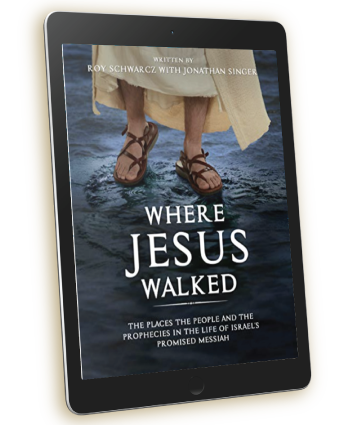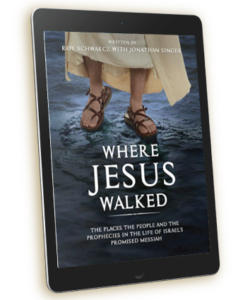Fall Feasts
As Christians we are thankful that we are no longer under the Law and the “observance” of new moons, feasts etc., there is great value in understanding the Law and the Feasts foreshadow.
Three of the 7 feasts occur in the fall, in the month of Tishri (September-October): The Feast of Trumpets, the Day of Atonement (Yom Kippur), and the Feast of Tabernacles.
While each of these feasts has a historical role, they also have a prophetic role. Jesus indicated this in Matthew 5:17: Think not that I am come to destroy the law, or the prophets: I am not come to destroy, but to fulfil.
Paul also emphasized that in Romans 15:4: For whatever was written in former days was written for our instruction…
The prophetic role of the feasts is also highlighted in Colossians 2:16 and 17:
Therefore let no one pass judgment on you in questions of food and drink, or with regard to a festival or a new moon or a Sabbath. These are a shadow of the things to come, but the substance belongs to Christ.
In artistic painting, shadowing gives perspective and dimension and highlights what the artist desires to portray. in much the same way God, in painting his portrait of redemption has put in the shadows first and then that which the shadows point to, Jesus and his plan of redemption for man and the world.
The Fall Feasts foreshadow God’s prophetic Word. The 1st of the 3 fall feasts Rosh Hashanah considered the second most solemn day of the year.
Known as New Year, Rabbi Akibah wrote, “On New Year’s Day all men are judged; and the decree is sealed on the Day of Atonement;
The most significant aspect of Rosh Hashanah in Scripture is the blowing of the Shofar, or the rams horn. In Lev. 23:24: Speak to the people of Israel, saying, In the seventh month, on the first day of the month, you shall observe a day of solemn rest, a memorial proclaimed with blast of trumpets, a holy convocation.
From the Hebrew, we know that the trumpet, is the ram’s horn. The first mention in Scripture of the Rams horn is found in Exodus 19:13,19 the Hebrew word is Shofar, or ram’s horn. (Slides 1 & 2)
The blowing of the Shofar was God’s method of calling His children into the privileges of the Covenant. The blast of the Shofar was on Mt. Sinai at the giving of the Law in Ex. 19 when they heard the Trumpet.
What should Christians be reminded of when they hear the shofar of Rosh Hashanah? One of Israel’s greatest Rabbis taught what God’s chosen people should consider:
Maimonides (Rambam) wrote: “There is a message implicit in the Command to blow the Shofar on Rosh Hashanah … “Sleepers awake from your sleep! Slumberers, arouse yourselves from your slumber! “Search your deeds and repent and remember your creator.
These words echo those spoken by Jesus in the Book of Revelation 3:3 – Remember, therefore, what you have received and heard; obey it, and repent. But if you do not wake up, I will come like a thief, and you will not know at what time I will come to you. Slide 4
The the Rabbi’s list 12 things we should remember at the blowing of the Shofar on Rosh Hashanah. But for the sake of time I will only consider only one. The blast of the ram’s horn is to be a call to repentance.
Consider Ezek 33:1-11: Which is a call to God’s people to discern the times and repent and a call to evangelize the lost to repent.
Today when Jewish people celebrate Rosh Hashanah which fell this year on September 18, at sundown, they are taught that it begins 10 days of Awe. During this time, they hope to be inscribed in God’s book for life for another year.
God called His people to holiness so that they might fulfill their calling to be a nation of priests to the world.
Repentance is a necessary ingredient of holiness. The blast of the shofar is a call to repentance. In Jewish theology, Repentance is a pre-requisite for the Day of Atonement.
Paul writes in Rom. 11 that we Gentiles when they come to faith in Israel’s King Yeshua, they are grafted into Israel. And as both Old and New Covenant teaches God’s people are called to be Holy in 1 Pet. 1:14-16
As obedient children, do not be conformed to the passions of your former ignorance, but as he who called you is holy, you also be holy in all your conduct, since it is written, “You shall be holy, for I am holy.”
Israel was called to be holy so too are we. Israel was called to be a priestly nation, so too are we. Our holiness and righteousness comes from our faith in God who redeemed us and our response to His work on our behalf. Passover in the Old and the death of Yeshua in the New.
As Israel was disciplined for sin so too shall we. Hebrews tells us:
My son, do not regard lightly the discipline of the Lord, nor be weary when reproved by him. For the Lord disciplines the one he loves and chastises every son whom he receives.
We would do well to remember that entrance into and abiding in the kingdom of God is through repentance. Scripture clearly teaches that sin separates us from God because of sins. Isaiah 59:1-2
Surely the arm of the LORD is not too short to save, nor his ear too dull to hear. {2} But your iniquities have separated you from your God; your sins have hidden his face from you, so that he will not hear. Slide 5
The prophet Isaiah taught that One would come upon whom our sins would be transferred. That His Servant Would come like a Lamb.
We all, like sheep, have gone astray, each of us has turned to his own way; and the LORD has laid on him the iniquity of us all. Slide 6
Jesus is this Lamb. John 1:29. The next day John saw Jesus coming toward him and said, “Look, the Lamb of God, who takes away the sin of the world!
So, when we hear the Shofar we are called to Repent. And to understand that we were redeemed through the Lamb of God. That’s why the Temple was destroyed for God has provided the Lamb and the result is we are written in the Book of Life.
Yom Kippur is considered by the Jewish community the most holy of all days. This was the day according to God’s Word that the multitude of Israel’s sins that had not been atoned for would be. Otherwise God would have had to separate Himself from the nation because of her sin.
Most Jewish people think that this is a day for personal atonement. But under the Law of Moses personal atonement could be provided every other day as outlined in Lev. 1-5 with various offerings.
On Yom Kippur, the Tabernacle and later the Temple was closed to all except the High Priest who would go through offerings laid out in Lev. 16. It was on this day that the High Priest would intercede for all Israel.
Yom Kippur was for National atonement not personal atonement. Personal sacrifices were made through the daily sacrifices offered in the Temple. When a Jewish person sinned, he was to go as soon as possible to the Temple and make an offering of blood.
He would then experience atonement. His sin was covered by the blood of the offering until he sinned again and sensed his separation from the Lord. Atonement comes from the word Kifar and means literally Covering.
There are three things that we can do with our sins. 1) Ignore them pretending they don’t exist or rationalize them away or 2) Think we can work them off by our good deeds or 3) Respond God’s way by receiving His provision for our sin.
According to the Law and the prophets God hid his face from the soul that sinned. (Isaiah 59:1-2) Behold, the LORD’S hand is not so short That it cannot save; Nor is His ear so dull That it cannot hear. {2} But your iniquities have made a separation between you and your God, And your sins have hidden His face from you so that He does not hear. Slide 7
The way God provided for fellowship for our restoration was through the sacrifices. The blood of the offering would cover Israel sins so that forgiveness and reconciliation might be experienced.
This is most important in understanding the reason for Jesus’ death. The prophets foretold that the Messiah would be our atoning sacrificial Lamb (Isaiah 53).
But as I said Yom Kippur was not for personal atonement but rather National atonement.
When the Temple stood the multitude of sins committed by Israel that had not been atoned for would cause God to end his covenant with them but in His grace, He gave the Nation the annual Day of Atonement as a provision to cover national sin.
When the Tabernacle and later the Temple would stand (Slide 8 & 9) The high priest on behalf of the nation would enter through the veil that separated the holy place from the Holy of holies (Slide 10). And offer two special Syrian Goats the first for sin the other as the scapegoat (Slide 11).
The Blood of the sin offering would be put on the mercy seat of the Ark of the Covenant (Slide 12). Then the High Priest would come out and lay his hands on the other animal known as the Scapegoat (Slide 13)
On Good Friday 2,000 years ago, the veil in the Temple was torn asunder (Mat. 27:51) (Slide 14) demonstrating that God ended the Mosaic Covenant and instituted a New Covenant which Jeremiah 31:31-33 had prophesied.
God provided a different means of Atonement. To underline the point in 70 A.D. The Temple was destroyed. No longer would that way of atonement provide reconciliation to God. Even the Jewish writings bare witness:
Rabbi Jochanon Ben Zakki the chief leader of the Pharisees came up with an alternative. He taught Israel that Repentance, Prayer, and acts of mercy would now be the sacrifices acceptable to God.
This contradicts the teaching of the prophets. Lev. 17:11: For the life of the flesh is in the blood, and I have given it for you on the altar to make atonement for your souls, for it is the blood that makes atonement by the life.
Rabbi Johannon however was not convinced of his teaching. Listen to his dying words recorded in the Talmud.
“When R. Jochanan Ben Zaccai was taken ill, his disciples said unto him, ‘O Light of Israel, Pillar of the Right Hand, Strong hammer, why dost thou weep? He answered and said unto them…
‘Now when I am to be led into the presence of the King of kings, the Holy One, blessed be He, who lives, and is through all eternities, whose anger if He is angry with me is an eternal anger: Whose fetters if He will bind me are everlasting fetters and whose death if He put me to death is an eternal death; whom I cannot appease with words, nor bribe with money; and not only so, but two ways open before me the one leading to Paradise and the other to hell (Ghenna), and I do not know upon which of these two ways I shall be led, shall I not weep?”
In the Talmud the Rabbis comment that something changed happened at the time Jesus died. It is found in the tractate Yoma 5B, and concerns the historical account of Azzazel the Scapegoat spoken of in Lev. 16.
A scarlet thread was placed around the goat, after the final offering of the Lamb in the Holy of Holies the High Priest would lay his hands on the goat and the scarlet ribbon was removed.
The ribbon was placed on the outside of the Holy Place for all to see. The goat was then driven into the wilderness where it died. The scarlet thread, according to the Talmud, changed from red to white at the death of the scapegoat.
It was a sign to the nation from God that National sin was forgiven, and the covenant was renewed. But the thread stopped changing color about 35 years before the Temple was destroyed. The Talmud writers wonders why? We who believe that Jesus is the Messiah know why, because Jesus died at that time, and the veil that separated the Holy place from the Holy of Holies was rent in two (slide 14), signifying that a New Covenant has come.
Finally, the last fall feast is Tabernacles. There are several important requirements of this feast. But I only have time to consider one. They were designed to help Israel remember the God who provides.
The first requirement was the building and dwelling in Booths, this is something Jewish people still do today. In Lev. 23:42 we read that a booth must have at least 3 walls and a roof made of boughs. These booths were to be their dwelling during the eight days of celebration. (Slide 15)
V. 43 tells us why they were to live in booths. “So that they might know that I had the sons of Israel live in booths when I brought them out of the land of Egypt”.
Dwelling in the Sukkah or tabernacle was given by God for Israel to learn and remember important truths. For example, When we dwell in a Sukkah we leave our permanent dwelling for a temporary one. It is to remind us of the temporary dwellings our fathers lived in when they were in the wilderness.
In the wilderness they were exposed to elements beyond their control, including serpents, erratic weather, inconsistent water and food. It took faith and trust in God. This is one of reason why Jewish people traditionally read from the 118th Psalm.
{8} It is better to take refuge in the LORD Than to trust in man. {9} It is better to take refuge in the LORD Than to trust in princes.
Another lesson in building and dwelling in the Tabernacle is that to the powerful and wealthy the Sukkah says “don’t rely on your wealth and power Its transitory.”
It can leave you more quickly than it came. Even in a mansion you are no more secure than in a Sukkah. God is the one who protects and judges. It is He who builds hedges to protect us and He is the one who removes them.
If you are safe, it’s because God shelters you as our fathers were sheltered in the wilderness. The sky we see by day and the stars we see at night through the greens of our sukkah remind us that our lives need to be built on a sure foundation of Faith in God and His Word.
To the Poor and Downtrodden the Sukkah says “Are you more helpless than our fathers in the wilderness? Are you without a reliable source of food, water, or permanent shelter? What sustained them in the wilderness?
Who provided for them? Who calmed their fears and worries? Look at the flimsy walls of this sukkah, and at the sky through the roof. Let it remind you that Israel became a nation while dwelling in such mansions.
This was the housing for a nation of kings. This was the Temple for a nation of Priests. This is the kind of structure where faith and confidence in God is developed.
The Sukkah should remind us that our lives are temporary, I believe this is what Paul had in his mind when he wrote 2 Cor. 5:12.
For we know that if the earthly tent which is our house is torn down, we have a building from God, a house not made with hands, eternal in the heavens. {2} For indeed in this house we groan, longing to be clothed with our dwelling from heaven;”
We need to remember that we are just passing through. We are strangers and exiles. The Sukkah reminds us that God Himself dwelt in a Tabernacle with Israel, and tabernacle among us in the Body of Jesus. Just as Israel was led through the pillar of Cloud by day and fire by night, so too are we led by the indwelling cloud the Holy Spirit.
In closing it’s worthwhile to consider that Sukkot was the only feast that consisted of 8 days. In Scripture the 8th day speaks of resurrection. And in God’s timetable Sukkot speaks of the resurrection of the world spiritually. A time spoken of when a great voice out of the throne of heaven shall declare
“Behold the tabernacle of God is with men, and he shall dwell among them, and they shall be His people, and God Himself shall be among them.”
This day will be fully fulfilled when the Lord will rule and reign on the earth during the millennial kingdom. Zech. 12:14 speaks of that glorious day.


